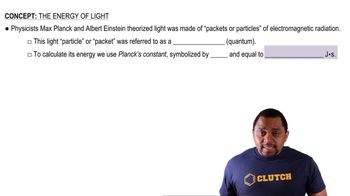Here are the essential concepts you must grasp in order to answer the question correctly.
Ionization Energy
Ionization energy is the amount of energy required to remove an electron from an atom in its gaseous state. For bismuth, the first ionization energy is 703 kJ/mol, indicating the energy needed to remove the outermost electron. This concept is crucial for understanding how much energy is necessary to ionize an atom and relates directly to the wavelength of light that can provide this energy.
Recommended video:
Photon Energy and Wavelength Relationship
The energy of a photon is inversely related to its wavelength, described by the equation E = hc/λ, where E is energy, h is Planck's constant, c is the speed of light, and λ is the wavelength. This relationship means that longer wavelengths correspond to lower energy photons. To find the longest wavelength capable of ionizing bismuth, one must calculate the wavelength that corresponds to the ionization energy.
Recommended video:
Frequency-Wavelength Relationship
Planck's Constant
Planck's constant (h) is a fundamental constant in quantum mechanics, valued at approximately 6.626 x 10^-34 J·s. It relates the energy of a photon to its frequency and wavelength. Understanding this constant is essential for calculating the energy of photons and determining the wavelength of light needed to achieve specific energy transitions, such as ionization.
Recommended video:
Photons and Planck's Constant




